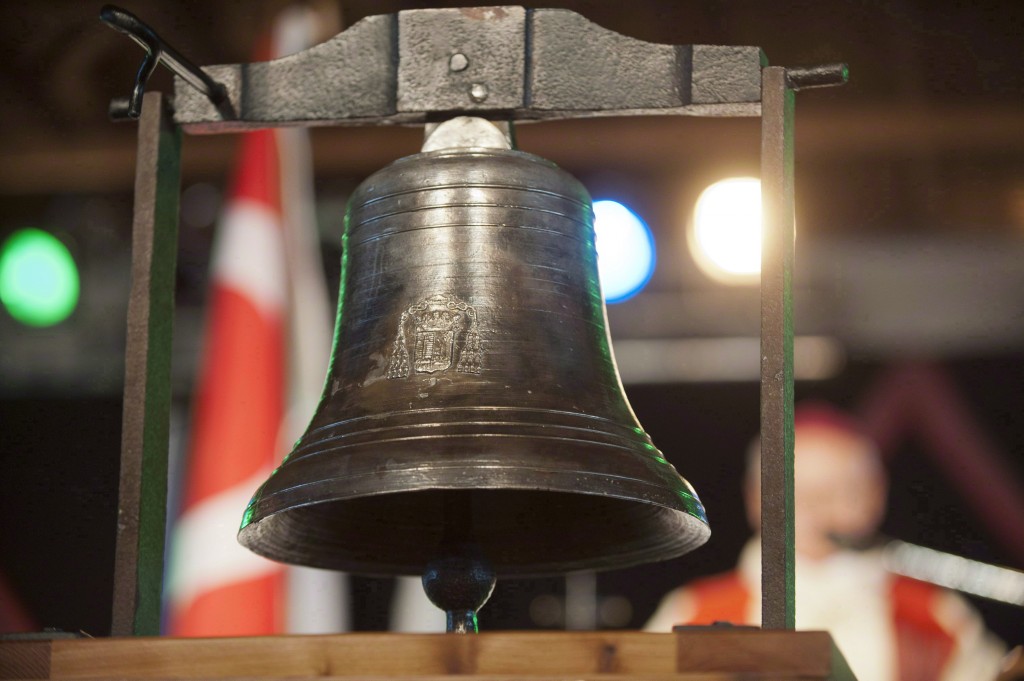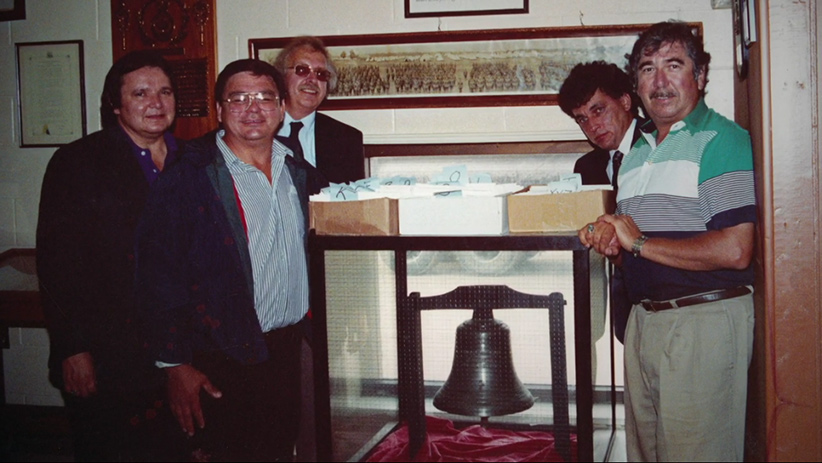One of the biggest mysteries in Metis history gets even more puzzling
Billyjo Delaronde stole and hid the Bell of Batoche—ripped from the Metis in 1885, and held in a legion—for 22 years before giving it up. Now, in a way, it’s missing again.
The Bell Of Batoche is official displayed during Back to Batoche Days in Batoche, Sask., on Saturday, July 20, 2013. (Liam Richards/CP)
Share

Just when you think the mystery behind the Bell of Batoche has finally been put to rest, something unexpected happens to kick up a hornet’s nest of new questions. And those questions usually involve former Métis leader and activist Billyjo Delaronde.
The man who re-stole the 20-kg, silver-plated Bell of Batoche in 1991 from the descendants of Canadian soldiers who originally stole the bell in 1885 from the Métis of Batoche, now has that bell again—and he ain’t sayin’ where it’s at. Again.
But, then again, he says he is the “Keeper of the Bell,” which is now legally owned by a Métis woman in Alberta named Audrey Poitras, who also happens to be the long-time leader of Alberta’s Métis people. And she’s not saying where that bell is, either—if it is the Bell of Batoche at all.
And if you’re still confused by all this, just think how that poor, young Millbrook Legion Hall janitor in Ontario felt when this entire controversy began, when he opened the door to the pub one morning in 1991, saw broken glass on the floor around an empty display case, and simply uttered in half-shock and disbelief: “Oh s–t. They took the bell.”

Let’s start from the beginning. Rather than simply re-state Canada’s official view of the Louis Riel-led North-West Rebellion in 1885, which has the heathen, savage Indians making common cause with their brown papist brothers, the Half-Breeds, and discussing the battles of Batoche and Frog Lake from the victor’s perspective, let’s just skip to the end result: both communities were sacked, Batoche and Frog Lake looted and plundered by racist Orangemen from Ontario, under the proud white banner of Canada and its military.
The Bell of Batoche, along with the Bell of Frog Lake, was said to have been carted off secretly by white militiamen bent on collecting as many war trophies as possible.
It’s an important piece of history for the Métis people. “The Bell of Batoche, to me, is the connection to our past, and to our ancestors,” said Audrey Poitras, president of the Métis Nation of Alberta (MNA), in an interview this week. “As a Métis person, I heard about the Bell of Batoche all my life, so of course it matters. The Bell of Batoche was used as a community icon that called our people together for all sorts of reasons. And of course it really matters that it was stolen from us all those years ago.”
And for many, it’s a symbol of the ruthlessness with which the 1885 Rebellion was put down. As a surprisingly sympathetic Toronto Mail reporter at Batoche wrote at the time: “Stoves, clocks, bedsteads, tables etc. were all mercilessly destroyed by these raving maniacs. The soldiers have robbed and destroyed everything they could lay their hands on in that region, leaving the residents in the most destitute conditions.”

Fast forward 105 years later to 1990, and CBC’s Dan Bjarnason is reporting on the bell in Millbrook, Ont. In Manitoba, Yvon Dumont, the Manitoba Métis Federation president from 1984 to 1993, and Manitoba’s first-ever Métis Lieutenant Governor, is watching the report—as is his young, curly-haired political protege from Duck Bay, Man., Billyjo Delaronde.
After a short, nostalgic review of the “rebellion” and the battle at the Métis settlement about 90 kilometres north of Saskatoon, Bjarnason cuts straight to the tale of the Bell of Batoche.
“It’s here in Millbrook, Ontario, which sent a platoon out west to join the fight against Riel. They smuggled the looted bell back in a blanket and hid it in the local creek. It’s ended up here in the local Legion hall, preserved as a war trophy, embedded in cement.”
This CBC story was more than likely inspired by an unsuccessful 1990 letter to the Millbrook Legion from the Saskatchewan Métis, requesting the return of the bell to Batoche.
But as an old-time Millbrook resident and Legion member explained to the CBC camera: “We got it. You tried to wreck the country and we stopped ya. And we got the bell. It’s ours. Can ya get it any plainer than that?”
And apparently, there was really no way to get any plainer that. Shortly after that story, in Oct. 1991, a five-man Métis diplomatic mission was sent to Millbrook, Ont., headed by Dumont, with his first lieutenant Delaronde, to appeal to the better angels of the men who now had the Bell of Batoche displayed as a war trophy in a drinking establishment.
What exactly happened next remains something of a mystery. But what is plain is that one week later, this controversial historic bell—along with three medals, belonging to Sgt. Ed McCorry and his two nephews, Millbrook soldiers who were at the Battle of Batoche—went missing from the legion. And for 22 years, no one claimed to know where it was.

That mystery endures, in large part, because of Delaronde himself. As any reporter who has ever interviewed him will tell you, he answers questions about the bell like he’s doing a Dance of the Seven Veils—in a slow, annoying striptease that continually tempts the listener with seductive glimpses of the truth, but never the whole truth, nor the nasty, good parts.
He’s also prone to self-serving self-flattery. A “Métis Mission Impossible,” a “gentleman’s dare,” and an “act of repatriation”—he’s used all these phrases over the years to describe his break-and-enter. He’s a divisive figure, even among the Métis; he is either demonized by his political enemies, or strongly promoted as a noble, saintly figure by his supporters (and also rather strenuously by himself.) And his story about the break-in—and who was involved and how the bell was taken—has also changed over the years.
But that’s just “Billyjo.” One minute you’re frustrated with him. The next minute you can’t help but like him. The man oozes warmth, charm and genuine affection, so much so that even the former sergeant-at-arms at the Millbrook Legion, who drank with Billyjo and his Métis party of adventurers shortly before the 1991 break-in, was ready to forgive the theft of the stolen Métis bell—provided that the three medals that also disappeared were simply returned.
Delaronde’s story, now, is this: about a week after his original 1991 visit—on Louis Riel’s birthday—he jimmied the lock to gain entry to the Millbrook Legion without causing any damages, and liberated the bell that was christened in the 1800s by Bishop Vital-Justin Grandin with the name “Marie Antoinette” from her prison with an accomplice he refused to name, with whom he then lit out of town in his Jeep Cherokee.
The first snag to the getaway, Delaronde said, came when the car broke down in Thunder Bay, forcing them to grab a bus back to Winnipeg. The next snag, he continued, was when the bell kept making a loud gonging sound from underneath the bus every time they went over a bump, which necessitated a quick, panicked re-pack of the bell at the next available stop.
But Delaronde, his accomplice and the Bell of Batoche—or the Bell of Frog Lake, depending on who you talk to, more on that later—finally did make it back to Winnipeg.
It popped up, from time to time. In 1995, the Winnipeg Free Press published a story in which sources claimed that Delaronde, then the newly elected MMF president, held an election party in Gran Marais, Man., where the Bell of Batoche was on display, and party guests each took turns “gonging” the bell, including a senior Manitoba government minister; that minister later claimed that he never heard of the Bell of Batoche before or even knew that he may have been “gonging” possible stolen property.
In 2005, Gary Floyd Guiboche—serving a life sentence for killing his common-law wife—told The Globe and Mail that he was one of the two people to have stolen the bell, but refused to name who stole it with him, instead urging his partner to bring the bell back to light. “I think we should be recognized as a legend in our people, in our history,” he said. (Delaronde says Guiboche had nothing to do with the heist.)
Then, on July 20, 2013, Billyjo Delaronde finally returned the Bell of Batoche—wrapped in buffalo skins and a Métis flag—to Monsignor Albert Thevenot, who is also Métis and the Bishop of the Roman Catholic Diocese of Prince Albert, at a special ceremony in Batoche, at the annual “Back to Batoche” Métis festival.
What was lost, now was found. A 22-year-old mystery was finally solved. Or so we thought.
“I think the real story is how poorly our people were treated after the resistance,” says Geordy McCaffrey, executive director of the Gabriel Dumont Institute (GDI) in Saskatoon, considering the initial 1885 rebellion. “We just stood up to assert our rights to the land there—to protect our way of life there. And the Canadian army just turned its guns on us. We were burnt out, starved out, chased out. Our church and our homes were robbed, burned and looted. That to me is the important story—not whether this is or is not the Bell of Batoche.”
Indeed, in yet another twist in this story, there are some questions as to the bell’s authenticity. According to Professor Fred Shore, a Métis historian at the University of Manitoba, the weight of historical evidence, including a 2014 CBC documentary and its endorsement by the director of the St. Boniface Heritage Centre, strongly suggests that the original Bell of Batoche was actually destroyed in a 1990 fire, and that what was now being touted as the famed Métis bell was probably the Bell of Frog Lake, stolen at the same time. Poitras, however, cites the oral history of her Métis family, who have figured prominently in both the historic Red River Settlement and Batoche, in strongly disputing the CBC’s claim that the Bell of Batoche is really the Bell of Frog Lake. While she stated that she strongly sympathized with some of the Plains Cree people at Frog Lake who now believed that the bell now in her possession really belonged to their community, she urged them to look to their people’s own oral history, instead of accepting CBC news stories at face value.
Either way, the bell did find its way to McCaffrey’s GDI Centre last summer, after it was exhibited at the Back to Batoche Days festival last July, and he says it remained at the centre until about Nov. 15, 2016. That’s when, he says, it was picked up by Delaronde and Poitras, who claimed that she is now the legal owner of the bell, per the Bishop of Prince Albert. Indeed, last November, the CBC ran a story that the bell had gone missing, but it was really on display at the GDI Centre, where McCaffrey was seeking direction on what to do with it.
“The bishop pretty much told me that he had given the bell to Audrey [Poitras],” says McCaffrey. “So, when she and Billyjo [Delaronde] showed up last November asking for it, we just released it to them. But it’s been displayed at quite a few schools here in Saskatoon.”
Why the Bishop would give the bell to Poitras is unclear, though reports in the St. Paul Journal suggest that Frog Lake may have been working to get possession of the bell. (The Prince Albert Bishop’s office declined to speak to Maclean’s for this story, beyond directing comment to Poitras.) This threat of possible litigation could also explain why both Poitras and Delaronde would only say that the artifact was being kept in a “secure location” when asked repeatedly where it was.
And while many may now question the wisdom or efficacy of making Poitras the sole legal owner of what may very well be the Bell of Batoche, this new legal ownership could trump legal efforts from residents of Frog Lake to gain possession of the bell for their community.
“Let’s be perfectly clear here: the Roman Catholic Church, now represented by the Prince Albert Diocese, has always been the owner of record for this bell,” says the historian Shore. “This bell—and a bunch of others at the time—was commissioned by the church, paid for by the church, and placed in several of their churches in what was then the Canadian North-West. So if the church now wants to give this bell to the Métis—or to the people of Frog Lake—that is their right and prerogative. It’s really that simple.”
Poitras agrees: “The Bell of Batoche is owned by myself, Audrey Poitras—as a private Métis citizen,” she says. “And this legal ownership was established through a process specifically set up by Bishop Albert Thévenot of Prince Albert.” Under the terms of this 2015 letter and written agreement, Poitras—who says she’s merely the legal conduit to ensure the bell would now be preserved for all Métis people—received full legal ownership of the bell in return for her agreement to personally shoulder any and all financial burdens that may result from future litigation in relation to the bell, whether it’s from Batoche or elsewhere.
What happens to the bell now remains unclear. It has been displayed from time to time at community events, including most recently at the Westmount Community School in Saskatoon in mid-June. It was not displayed on National Aboriginal Day, Poitras says, because no community group had asked her to do so.
As for Billyjo Delaronde, whose break-and-enter helped ignite this drama? Poitras says he had been given the title of “the Keeper of Bell” when he finally returned the Bell of Batoche back to the church in 2013, at a special ceremony in Batoche.
“The Bell of Batoche is a physical reminder that what our ancestors talked about and what they endured was real and not a fairy tale,” he says, looking back on this now. “And why it’s important is because it’s a stark reminder that we’re ever present today—and that we’re not lost in some ember of history, to be encased and looked at as a relic or a war trophy.”
D.W. Langford is a member of the Kahkewistahaw First Nation of Saskatchewan and the former director of communications for the First Nations Resource Council (FNRC) in Edmonton. He has also worked as both a mainstream and Native media journalist, as well as a communications consultant for First Nations and Métis groups across Manitoba, Saskatchewan and Alberta.